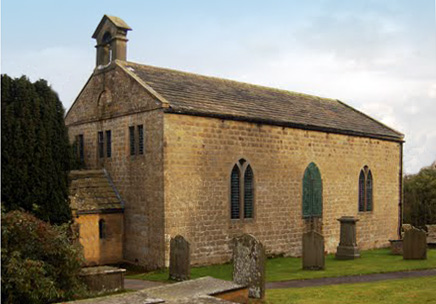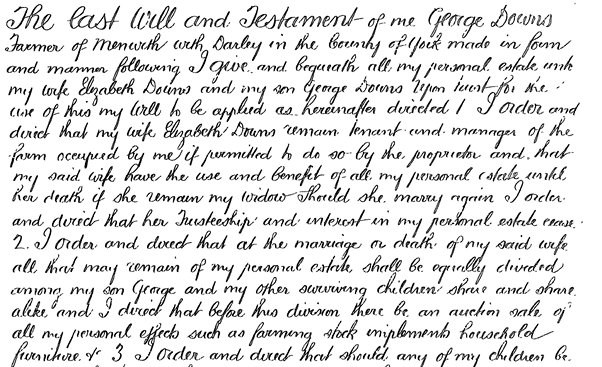This is part of a series of brief biographies of earlier ancestors.
I turned to Elizabeth & George as part of a plan to ensure I’d fully captured all relevant documents for each of my great, great, great grandparents. A Darley farming couple, I didn’t expect this to be more than a short biography but when I looked into those documents I found a wonderful story of a woman who really came into her own upon the death of her husband.
Darley-cum-Menwith is a typical Yorkshire farming village. Today it is a sought after country location close to Harrogate, commutable to Leeds and right on the borders of the Yorkshire Dales. In the mid-nineteenth century it was a thriving village. The 1841 census lists 725 people living in around 150 households who worked in agriculture or as shoemakers, linen weavers and wheelwrights. There was a church, two methodist chapels and a friends meeting house, a school, grocers and public houses. It was a self-contained village – even the arrival of a railway station in the 1860s meant you took a day trip to Harrogate, it didn’t mean you married out of the area.
The Great British Agricultural Depression was yet to hit and Darley was thriving.
So let’s meet Elizabeth & George at the time of the railways and specifically in the year 1866. Elizabeth was 49, George eight years older. Elizabeth was born in Darley in 1817, the daughter of a local farming couple, Mary Pullan & Joseph Furniss, and she married George Downs, on 2 November 1836 at the age of nineteen. George, aged twenty-seven when they married, was the third son of another local farming family, Mary Beecroft & John Downes. The couple spent their early married life living with George’s parents no doubt whilst they were searching for a suitable tenancy. Such was the life of a third son and those they married.

By 1866 they’d made it – 30 acres of land on Craike Lane and six surviving children, Mary (b. 1836), Salina (b. 1839), George (b. 1841), Elizabeth (b. 1847), John (b. 1852) and Ann (b. 1858). There’s a reason for choosing 1866 and it’s not just about the railway. On 22 September of that year, Elizabeth & George’s eldest daughter, Mary, married Thomas Houseman, another local farmer, and that union ultimately led to me. I can imagine that wedding at the beautiful Thornthwaite church with the trees turning their autumn colour. There would have been the traditional seating complications as Elizabeth’s brother, John, had married the groom’s sister, Mary, but at least that likely ensured family presence. The date was no doubt chosen to be post harvest and it wouldn’t surprise me if the ceremony was scheduled to allow for milking time. Elizabeth & George could be proud of the family they had brought up.
Then, just over a year later, on 7 December 1867, George wrote a will. Maybe he was already ill or maybe he was approaching 60 and conscious of his young family. Whatever the reason, it was timely, he died a few months later, on 21 May 1868.
It was a precarious time. Elizabeth, aged 51, was left to raise a family the majority of whom were female and under age. The eldest son, George, had married, the younger son, John was just sixteen. Farm tenancies didn’t pass automatically to women or underaged boys. The Great Agricultural Depression was just starting and farming was becoming less viable. It would have been very easy for the family to progress to the workhouse.
It is the will that suggests that Elizabeth had this under control. Written months before he died it suggests a confidence in her ability and the likelihood of a couple who had discussed and prepared for George’s death.

George asks that Elizabeth “remain tenant and manager of the farm occupied by me if permitted to do so by the proprietor.” He orders that the “remain of my personal estate shall be equally divided among my son George and my other surviving children share and share alike” and directs that “before this division there be an auction sale of my personal effects such as farming stock implements household furniture etc”
The normal practice is for fathers to leave the bulk of their estate to their eldest son to ensure a viable farm is passed on. The only exception being where an eldest son is already fully set up in business or they have fallen out, and as the son George is named as an executor that doesn’t appear to have been the case. George didn’t do this – he intended for his wife to remain in charge, split his estate equally and specified that everything should be sold before the estate was split. My personal experience is it’s incredibly difficult to properly value everything in a farm business and incredibly expensive to set up from scratch. If you want to ensure equal inheritance this is the way to do it, but it runs the very real risk that none of the sons inherit sufficient to set up on their own.
What all of this (together with other evidence) suggests is that Elizabeth was very much a partner in this farm and that George cared deeply about his wife and all his young family.
Elizabeth took on the tenancy of the farm and by 1881, at the age of 64, had doubled the acreage. Her remaining children went on to marry well and all lived long fulfilling lives. Ten years later, in 1891, aged 74 she was living with her daughter, Ann, but was described as living by independent means. Ditto 1901 and 1911. Finally, at the age of 94, Elizabeth died on 31 July 1911. She lived almost half her life as a widow and had thrived.
___________
There are missing pieces to this story. I am sure there are documents concerning the passing of the tenancy and I know there’s a lot more I could write about the life of farmers at this time. However, the big gap for me is that I have no photo of Elizabeth. Despite this competent and, quite possibly, formidable woman reaching the grand old age of 94, I’ve found no trace of an obituary, her story or any photos. This blog is the start of a journey to rectify that.
With much gratitude to Nathalie Pithers for running the excellent Curious Descendants Club at which Tina Konstant ran such an inspiring story telling session that I spent the rest of the evening writing this blog and, of course, to Elizabeth Furniss & George Downs, my great, great, great grandparents through my paternal Grandad, for leaving me such a wonderful story to write.
